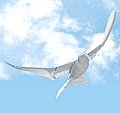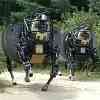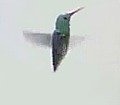Cool Inventions
Flying Robots

This cool invention is a flying robot that imitates a bird. It takes off, lands and flies like a real bird.
This flying robot has a two-meter wingspan, and a lightweight (450 gram) carbon-fiber skeleton body.
It uses hybrid drive technology to simulate the flying characteristics of the Herring Gull. The design imitates the construction and the motion of the wings during flight.
Birds have a down-stroke and a characteristic up-stroke of their wings, but they also twist to change angles for maneuverability and directional control.
The Smart Bird mimics this capability by using a flexible articulated torsion drive that allows the robot to autonomously twist for maximum flight efficiency - just like real birds.
This technical adaptation is quite an accomplishment in aerodynamic engineering. The project also provided innovated research into material construction and energy consumption efficiency.
Source: festo.com
Military Robots
 For decades the Marine Corps in Bridgeport, California has taught soldiers how to handle and use mules.
For decades the Marine Corps in Bridgeport, California has taught soldiers how to handle and use mules.
Mules have been used in practically every military engagement since the Civil War and most recently in Afghanistan. A mule's ability to carry equipment and supplies is legendary.
It has the size and agility of a horse but is stronger, has untiring stamina, and requires less food. A mule can carry four hundred pounds (181 kgs) of gear, seven hours a day, for three weeks, through rough terrain.
The military refers to mules as a "force multiplier" because they can triple the effectiveness of a troop by reducing the weight carried by soldiers. Less weight means less physical strain and fatigue.
Over the years, the military has relied less on mules and more on Jeeps and Humvees but these vehicles can't be used in rugged mountainous regions like Afghanistan.
Mules are still used in these areas to carry everything from anti-tank rockets and anti-aircraft missiles to body armor, boots and bullets. But mules can get sick and they require trained handlers.
 So DARPA (Defense Advanced Research Project Agency) contracted the robotics design company, Boston Dynamics, to develop a military robot to replace the mule.
So DARPA (Defense Advanced Research Project Agency) contracted the robotics design company, Boston Dynamics, to develop a military robot to replace the mule.
The Legged Squad Support System (LS3) is intended to carry supplies through the same terrain as ground troops - just like mules.
The LS3 is capable of interacting with humans and can understand verbal and visual commands. The four-legged robot can lie down, stand up, walk or run.
Sources: darpa.mil;newyorker.com;.bostondynamics.com Images: darpa; sashachoi
Nano Hummingbird
 Nanotechnology has created some cool inventions and this nano robot is one of them.
Nanotechnology has created some cool inventions and this nano robot is one of them.
It was recently recognized by Time Magazine as one of the best inventions of 2011.
These types of robots are often funded as military robots for unmanned aerial vehicle research. The Nano Hummingbird was developed for the Nano Air Vehicle Program of the Defense Advanced Research Projects Agency (DARPA).
The objective of this project was to model the flight characteristics of a hummingbird because of it's precision flying and hovering capabilities.
This robot flies in any direction, hovers, and can turn on it's own axis, which makes it ideal for entering and maneuvering within buildings.
It has a 6.5 inch (16.5 cm) wingspan, a flight speed of 11 mph (18 km/h) and a flight time of about 20 minutes.
The propulsion and control systems are embedded in the wings. It also carries a battery, transmitter and a color video camera. Amazingly, the whole thing weights less than a AA battery (19.5 grams).
Source: avinc.com/nano; darpa.mil
Types of Robots
These blind robot jugglers, as seen in the video below, are cool inventions.
Imagine bouncing a ball on your head while walking around a room. Now imagine doing that blind folded.
That's exactly what this flying juggling robot does.
Developed at the Institute for Dynamic Systems and Control in Switzerland, the blind juggler bounces a ping-pong ball without seeing it.
The robot accomplishes this feat without using any sensors to track the ball. Instead the robot is designed to carry out a sequence of mathematical and logical calculations to predict what the ball will do after it is bounced.
These calculations allow the robot to move and strike the ball repetitively without using any visual or motion sensors.
Source: idsc.ethz.ch; Related Article: Cool Inventions



